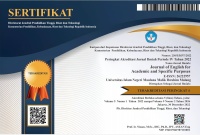CASE STUDY: THE ROLE OF LEARNING STRATEGIES, PERSONALITY AND MOTIVATION IN THE SECOND LANGUAGE ACQUISITION: WRITING PROFICIENCY OF A SOMALIAN STUDENT
Abstract
Full Text:
PDFReferences
Anderson, T. (2008). The Theory and Practice of Online Learning. Edmonton: AU Press
Bogdan, R. C., and Biklen, S. K. (1998).Qualitative Research for Education: An Introduction to Theory and Methods (3rd). Needham Heights: Allyn& Bacon.
Brown, H. D. (2000). Principles of language learning and teaching (4th ed.). New York: Longman.
Ditual, R.C. (2012). The Motivation For and Attitude Towards Learning English. ASIAN EFL Journal. 63, 4-21.Online. www.asian-efl-journal.com. Accessed in April 2nd, 2015.
Dörnyei, Z. (2001). Motivation and motivating in the foreign language classroom. Teaching and researching motivation (1st Ed.). New York: Longman.
Ehrman, M. & Oxford R. (1995). Cognition plus: correlates of language proficiency,
Modern Language Journal, 74, 311-327
Ellis, R. (1997). Second Language Acquisition. Oxford: Oxford University Press.
Ellis, R. (2008). Second Language Acquisition. Oxford: Oxford University Press.
Gardner, R. C. (2005). Integrative motivation and second language acquisition. Canadian Association of Applied Linguistics and Canadian Linguistics Association, joint plenary talk at the University of Western Ontario, London, Canada.
Gardner, R. C., & Lambert, W. E. (1972). Attitudes and Motivation in Second-Language Learning. Rowley, Mass.: Newbury House Publishers.
Graham, S., Berninger, V & Fan, W. (2007). The Structural Relationship between Writing Attitude and Writing Achievement in First and Third Grade Students. Contemporary Educational Psychology, 32, 516-536. (Online). www.sciencedirect.com
.Hedge, T. (2001). Teaching and learning in the language classroom (2nd ed.). Oxford: Oxford University Press.
Istianti, N. (2013). The Correlation Between Students’ Motivations in Second Language Learning. Unpublished Thesis. UIN Jakarta. Online.
MacIntyre, P.D. (1995). How Does Anxiety Affect Second Language Learning? A Reply to Sparks and Ganschow. The Modern Language Journal, 79, 90-99.
McKenna, M., Kear, D., & Ellsworth, R. (1995). Children’s Attitudes toward Reading: a National survey. Reading Research Quarterly, 30, 934–956. (Online)
Mertens, D. M. (2010). Research and Evaluation in Education and Psychology: Integrating Diversity with Quantitative, Qualitative, and Mixed Methods (3rd). California: SAGE.
Morris, G. (2011). Career Goals and L2 Motivation. An Investigation of Chinese College English Major’s L2 Motivational Drives.
Novita, L. (2016). Relationship Between Reading and Pronunciation and Students’ Speaking Skills. Unpublished Thesis. Universitas Negeri Solo. Online.
Oxford, R. L. (1990). Language learning strategies: What every teachis should know. Boston, Heinle & Heinle Publishiss.
Platt, H., Platt, J., & Richards, J. C. (1998). Longman dictionary of language teaching & Applied Linguistics (3rd ed.). Personal Education Asia Limited. Quarry Bay, Hong Kong.
Saville-Troike, M. (2006). .Introducing Second Language Acquisition.Cambridge: Cambridge University Press.
Selinker, L. (1972). Interlanguage. Product Information International Review of Applied Linguistics in Language Teaching, 10, 209-241.
Sharp, A. (2000). Language learning and awareness of personality type in Chinese settings. ASIAN EFL Journal. The EFL Professional Written Forum.Online. www.asian-efl-journal.com. Accessed in May 2nd, 2020.
Xiu, J. (2011). Second Language Learners and Their Self-confidence in Using English:
A Social Constructive Perspective. ASIAN EFL Journal. 13(3), 246-265.Online. www.asian-efl-journal.com. Accessed in May 2nd, 2020.
DOI: https://doi.org/10.18860/jeasp.v3i1.9771
Refbacks
- There are currently no refbacks.

This work is licensed under a Creative Commons Attribution-ShareAlike 4.0 International License.






Editorial Office:
Pusat Pengembangan Bahasa
Program Khusus Pengembangan Bahasa Inggris (PKPBI)
Universitas Islam Negeri Maulana Malik Ibrahim Malang
Gedung C lantai 1
Jl. Gajayana No 50 Kota Malang, Jawa Timur, Indonesia
Kode Pos 65144, Telp/Fax : (0341) 570872
Email: jeasp@uin-malang.ac.id
JEASP : Journal of English for Academic and Specific Purposes is licensed under a Creative Commons Attribution-ShareAlike 4.0 International












